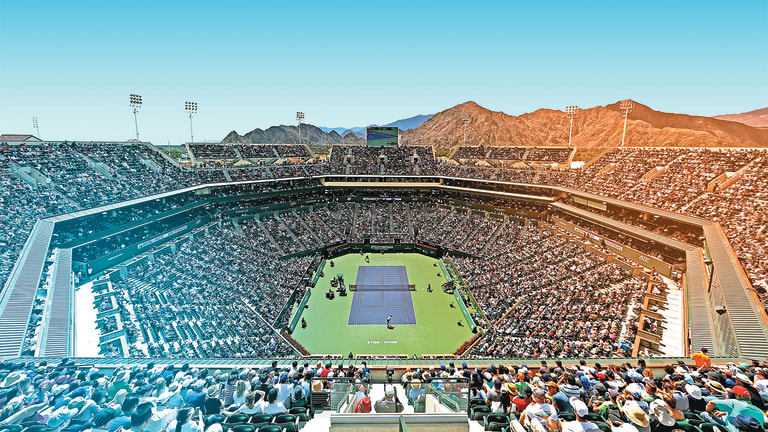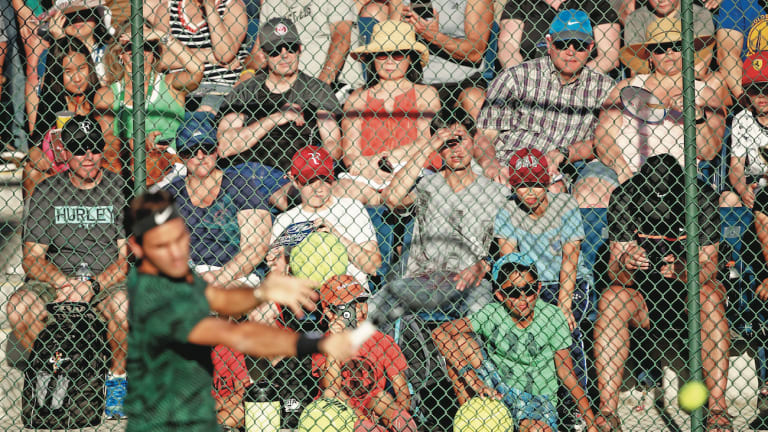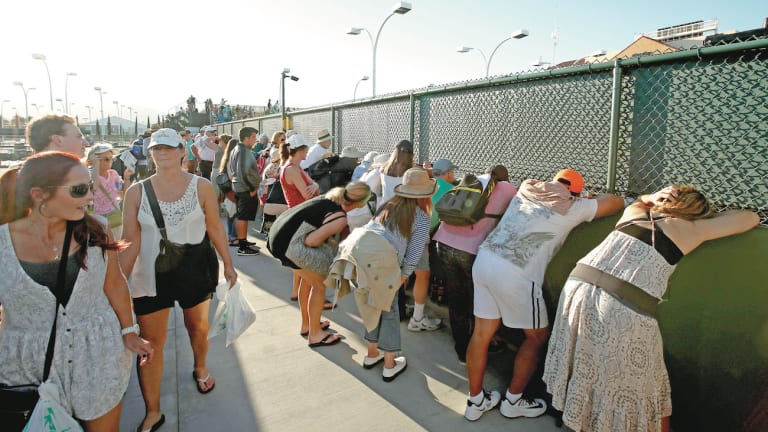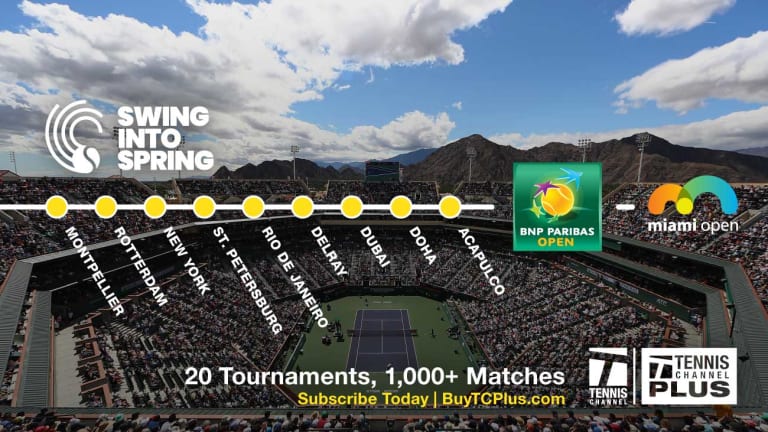One of a Kind: The Indian Wells experience we're missing this week
By Joel Drucker Mar 18, 2020Mackenzie McDonald is paying the college tennis experience forward with a new fund
By Ed McGrogan Mar 17, 2025Mirra Andreeva and Jack Draper win breakthrough titles at Indian Wells: What did we just witness?
By Steve Tignor Mar 17, 2025Jack Draper's run through Indian Wells concludes with his first ATP Masters 1000 title
By Ed McGrogan Mar 16, 2025Holger Rune vs. Jack Draper: Where to Watch, Indian Wells Preview, Betting Odds
By Steve Tignor Mar 16, 2025Holger Rune reaches first Indian Wells final over Daniil Medvedev
By David Kane Mar 15, 2025Mirra Andreeva vs. Aryna Sabalenka: Where to Watch, Indian Wells Preview, Betting Odds
By TENNIS.com Mar 15, 2025Mirra Andreeva, 17, advances to Indian Wells final, beating Iga Swiatek in chilly conditions
By Associated Press Mar 15, 2025Ruthless Aryna Sabalenka storms past Madison Keys, 6-0, 6-1, in semifinals of Indian Wells
By John Berkok Mar 15, 2025Carlos Alcaraz vs. Jack Draper: Where to Watch, Indian Wells Preview, Betting Odds
By TENNIS.com Mar 15, 2025One of a Kind: The Indian Wells experience we're missing this week
It’s been called the fifth major, and the West Coast Slam. But the BNP Paribas Open is doing just fine smoothly synthesizing comfortable dry heat and retirement community tranquility.
Published Mar 18, 2020
Advertising
Editor's Note: While this year's BNP Paribas Open will not be held, we still want to pay homage to one of the most important events on the tennis calendar. This story showcases the desert jewel Indian Wells has become—one of the many reasons why we miss it so much. We can't wait for it to gleam again.
The BNP Paribas Open, tennis’ annual West Coast summit in mountain-framed Indian Wells, CA, is unofficially considered the sport’s fifth Grand Slam. Deep player fields, elegant grounds and extensive, worldwide coverage add up to a compelling package that annually attracts thousands of attendees and millions of viewers.
But with innovation and intimacy as the tournament’s longstanding tenets, rather than tradition and grandeur, one wonders if comparison to a Grand Slam is the proper lens through which to view Indian Wells.
“Indian Wells has made everyone push to improve the venue and the fan experience,” says Butch Buchholz, founder and former tournament director of the Miami Open.
Between 1981 and 2000, Charlie Pasarell, Indian Wells’ founder and one-time tournament director, created three exceptionally cozy venues for his tournament, growing it into an unassuming behemoth. First came the development of a friendly tennis spot at the longstanding La Quinta Resort & Club. Then, in 1987, a larger facility opened in nearby Indian Wells that retained its predecessor’s charm. Thirteen years later, the tournament relocated to its current site, the 54-acre Indian Wells Tennis Garden—7.5 acres larger than the USTA Billie Jean King National Tennis Center—that took the event to another stratosphere. All while keeping its up-close-and personal California ethos.
“It’s always been as if you could reach out and touch the players,” says Pasarell, who continues to frequent the tournament today.

One of a Kind: The Indian Wells experience we're missing this week
© 2018 Getty Images
Advertising
No matter where you look, the Indian Wells Tennis Garden is a visual treat. The mountains on the horizon peer into Stadium One, an arena occupied by a dedicated fanbase and featuring tennis with serious stakes. Once in danger of moving, the Masters and Premier Mandatory-level tournament seemingly betters itself each year.
In the interest of enhancing the fan experience, Indian Wells was the first tournament to feature viewer-friendly purple-and-green courts. In 2011, less than 18 months after business mogul and tennis superfan Larry Ellison acquired the event—likely saving it from leaving North America—Indian Wells again led the way, becoming the first tournament to have Hawk-Eye replay technology and video displays on all match courts. Three years later marked the opening of Stadium Two, an appealing 8,000-seat arena that includes several restaurants from which spectators can watch tennis.
But it wasn’t enough, says current tournament director, and former world No. 2, Tommy Haas. “Stadium One was getting jealous,” he says. “It needed an upgrade.” By 2017, Stadium One had been renovated, including lower seats for better camera angles, remodeled suites, 21 new restaurants and concession areas, as well as Ellison’s version of Wimbledon’s Royal Box, the VIP Champions Club. In 2019, in a player vote, the BNP Paribas Open was named Tournament of the Year, in the ATP Masters 1000 category, for a record sixth time.
For Pasarell, who nonetheless harbors grand ambitions for Indian Wells, evolution can mean many things.
“You need to look at a lot of things, like playing best-of-five [set matches], or at least doing that in the semis and finals,” says Pasarell, who has also floated the idea of sets being played to five games, or a first-to-10-point match tiebreaker in lieu of a fifth set.
On the one hand, there’s Indian Wells’ desire to be part of tennis’ group of major tournaments. Yet to a great degree, this tournament’s penchant for proximity is an attribute fans often find more appealing than Grand Slams. As a Northern California 4.5 player once said, as she dashed from a women’s singles match on Stadium One to a men’s doubles battle featuring Rafael Nadal on a field court: “We play in the morning, go right to the tournament to see the practices, watch bits and pieces, eat and drink, then go straight to the bars and restaurants before we head back to our Airbnb.”
This isn’t Wimbledon—or the US Open. Better instead, as Indian Wells folklore goes, to pour tequila into your water bottle and give it a squeeze all day long.
In 1982, just as the personal computer was making its way onto desktops, an American trend analyst named John Naisbitt authored a book called Megatrends. It was a hit in Silicon Valley, the San Francisco Bay Area region where Ellison had co-founded a technology company that would come to be known as Oracle.
The most popular Naisbitt theory revolved around a concept dubbed “high tech/high touch.” According to Naisbitt, “Whenever a new technology is introduced into society, there must be a counterbalancing human response—that is, high touch.” Courtney Brunious is the associate director of the University of Southern California’s Sports Business Institute. He also plays tennis regularly and has attended the Indian Wells tournament several times.

One of a Kind: The Indian Wells experience we're missing this week
© 2017 Getty Images
Advertising
Once the subject of fan gazes as a player, Tommy Haas looks to improve upon the up-close-and-personal experience as Indian Wells’ tournament director. Courts and seating were designed with proximity in mind, including for player practices. “We are known for having one of the best facilities in the world,” he says. “The whole atmosphere, with such good access to the players, is excellent.”
“Fans in general these days are expecting a more technologically advanced experience,” Brunious says. “They’re there to watch [sports], but also want to have a second-screen experience—something that mimics what they’re doing at home, be it the chance to interact with social media, or pull up stats.”
Consider the way high tech/high touch played out at Indian Wells for Krystal Glasgow and Frankie Moulton, two residents of Wilmington, NC. On Sunday, March 12, 2017, their journey west began with a two-hour drive to Raleigh for a flight to Atlanta, followed by the cross-country leg to Los Angeles. The plan had been to dine in L.A., then drive two hours east to the tournament the next morning. But while on the plane, they saw that Glasgow’s favorite player, Roger Federer, was in action on Sunday night. She’d never seen him in person.
Glasgow and Moulton bought tickets while in the air. But there were snafus at both the rental-car counter and the hotel-to-tournament shuttle. Federer also wasn’t cooperative, taking just 51 minutes to dispatch his opponent, 81st-ranked Stephane Robert. By the time Glasgow and Moulton entered Stadium One, Federer was conducting his on-court interview.
“So we went online and saw that Federer and Nadal were both practicing Monday afternoon,” Glasgow says. “We got to the practice courts three hours early, made some friends and just enjoyed hanging out. "I’d much rather watch practice, see them play from just a few feet away, and even hear what they have to say.”
The practice courts are a major Indian Wells attraction. Be it for the zealous student or the star-struck dabbler, the opportunity to observe the likes of Federer, Nadal, Naomi Osaka and Serena Williams as closely as you would the two best at your club is part of what Haas calls, “tennis up close and personal—drinking, mingling, eating, watching.” This year, the practice court area will also feature a new coffee station, as well as bathrooms.
“It’s not just about the event and the matches,” Brunious says. “It’s about ancillary things—contests, restaurants, beer gardens, watching on the big screens, checking out practice, trying racquets.” Adjacent to the practice courts is a large grass field, where the players kick around soccer balls and exercise. As they exit this area, the players are quite comfortable talking selfies with fans and autographing oversized balls and apparel. The two hats Nadal signed for Moulton were among the precious possessions she took from her home when forced to evacuate during Hurricane Florence in 2018.
The Indian Wells feng shui is akin to baseball’s spring training season, only with far greater competitive stakes. The time of year and the desert locale smoothly synthesize comfortable dry heat (with the occasional scorching afternoon or chilly night) and retirement community tranquility. On the men’s side, the mix of a 96-player draw and best-of-three set singles matches has often compelled such superstars as Federer and Nadal to play doubles.

One of a Kind: The Indian Wells experience we're missing this week
© 2017 Getty Images
Advertising
This isn’t Wimbledon—or the US Open. Better instead, as Indian Wells folklore goes, to pour tequila into your water bottle and give it a squeeze all day long.
Tournament officials are rather tight-lipped about what’s to come next. There have been rumblings of another stadium, perhaps one that houses a museum honoring the region’s significant tennis history. There’s talk of how such technologies as streaming video and virtual reality can augment the viewing experience. Perhaps Indian Wells might be a venue casual enough to permit fans to cease having to wait for changeovers to take their seats, as well as finding a way to alleviate the exclusionary and poor optics of row after row of high-quality seats that often sit vacant, while their owners roam the grounds.
Now imagine if Indian Wells was formally elevated to the level of a Grand Slam event. The field would have 128 singles players. Even if new approaches were taken to scoring, it’s doubtful that top players would enter the doubles. “And let me ask you,” said a longstanding tournament attendee, “do you really think people want to come to the desert to watch five-set matches? No, they like going from one match to another, to enjoy the singles and the fast doubles matches too.”
Also, would the tournament be willing to expand its purse—perhaps at the expense of more fan-friendly comforts? The up-close-and-personal mantra would likely change, though probably not for the better. It would be hard to imagine players enjoying a practice session the way they do today at Indian Wells, to say nothing of fans strolling into their seats amid Grand Slam pressure.
Players these days at Indian Wells have been known to visit sponsor suites following their matches, for additional fan touch points. Would this continue in the wake of an arduous five-setter? Would they spend as much time on the soccer field, or be as cordial when approached for their signatures? Maybe; maybe not.
The fifth major? The distinction is worth the praise. But a cursory study of business history will tell you that Larry Ellison never entered any business category seeking to come in fifth. Tech and touch have paired nicely in Ellison’s desert tennis paradise. Does the Indian Wells management team truly wish to be embroiled in the complications of ITF politics? Moreover, why be the fifth of five when you can be one by yourself?

One of a Kind: The Indian Wells experience we're missing this week